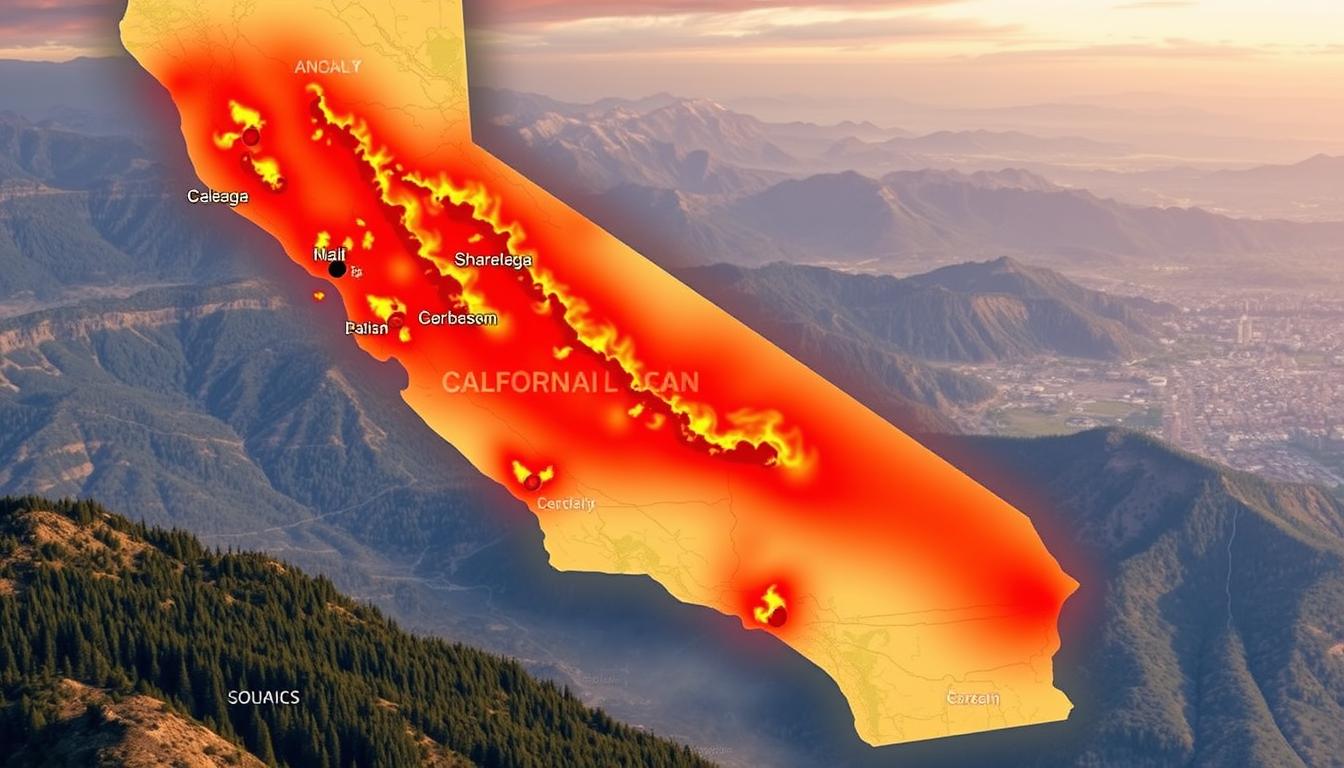The Live California Fires Map is a key tool for tracking wildfires in California. It helps residents stay updated on fire locations and assess risks to their homes. With real-time data, this map is crucial during the state’s dangerous wildfire season.
As fire patterns change, using resources like this map is essential. It ensures safety and readiness in our ever-changing climate.
Key Takeaways
- The California Fires Map provides real-time updates on active fires.
- Staying informed is vital during the heightened wildfire season.
- Tracking locations of wildfires supports better community safety.
- The 2023 wildfire season has seen over 7,100 incidents reported.
- Utilizing this map can help in emergency preparedness and response.
- Engagement with the map aids in understanding fire risks in specific areas.
Understanding California’s Wildfire Season
California’s wildfire season is now a year-round issue, thanks to many environmental factors. Wildfires are happening more often, posing big challenges for people and the state’s nature. It’s important to know what causes these fires to understand their effects.
What Causes Wildfires in California?
Several key elements contribute to the rising causes of wildfires in california. These include:
- Prolonged drought conditions, making vegetation highly flammable.
- Santa Ana winds, which can rapidly spread fires across various terrains.
- Human activity, including campfires and discarded cigarettes, often igniting dry brush.
The Impact of Climate Change on Fire Frequency
The link between climate change and wildfires is clear. Rising global temperatures have worsened drought, leading to:
- A significant increase in the annual number of fire days, up 78 days compared to 50 years ago.
- Increased intensity of wildfires, with years like 2020 witnessing over 4 million acres burned.
- Environmental degradation, resulting in the death of over 163 million trees in California.
Historical Data on California Wildfires
Analyzing california wildfire history shows alarming trends. Data indicates that:
- Wildfire season traditionally spanned from June to October, now it feels year-round.
- The Palisades Fire in Los Angeles emerged as the most destructive in history, destroying over 17,000 acres.
- More than 450,000 people faced power outages during major wildfire events, underlining the extensive impact on infrastructure.
| Year | Area Burned (Acres) | Percentage Increase in Fire Days | Notable Fires |
|---|---|---|---|
| 2020 | 4,000,000 | 78 | Palisades Fire |
| 2021 | 1,500,000 | 75 | Eaton Fire |
| 2022 | 3,000,000 | 80 | Multiple Fires |
How to Use the California Fires Map Effectively
The California fires map is a key tool for staying updated on wildfires. By using California fire tracker technology, you can see real-time fire updates and understand risks in your area. The map has interactive features for detailed monitoring and analysis.
Navigating the Interactive Features
Using the map’s interactive features can help you understand wildfire risks better. You can:
- Zoom in to specific geographic locations.
- Search for particular areas of interest quickly.
- View timestamped updates on active fire incidents.
Real-Time Updates and Notifications
The map offers timely California fire updates for planning and safety. It sends notifications for new fires, red flag warnings, and weather advisories. These alerts help you act fast when conditions change.
Customizing Your Viewing Options
Customizing your view is another great feature. You can:
- Assess fire perimeters to better understand affected areas.
- Identify thermal hotspots that indicate potential fire threats.
- Switch between different layers of data for a comprehensive look at hazards.
Learning these features on the California fires map helps you stay informed and ready during wildfire season.
Key Locations to Monitor on the Map
California’s landscape varies, leading to different fire risks in different places. It’s important to know which areas are most at risk. This knowledge helps with getting ready and staying safe.
Northern California Fire Zones
Northern California faces unique fire risks because of its varied plants and weather. Fire risks change with the seasons. Keeping an eye on the map helps everyone stay safe and informed.
Southern California Fire Zones
Southern California is at high risk for wildfires all year. It’s had very little rain since October, making fires more likely. Dry plants and strong winds make things worse. It’s crucial to watch for updates and follow evacuation orders.
Major High-Risk Areas
Knowing where fires are most likely to happen is key. Places with strong winds and dense plants need extra attention. Fires have forced many to leave their homes, especially in Los Angeles County. Staying updated helps people prepare and stay safe.
The Importance of Wildfire Preparedness
Wildfire preparedness is key to protecting homes and lives. With wildfires on the rise in California, being proactive is crucial. Knowing how to keep your home safe can help protect your property and keep your family safe.
Steps to Prepare Your Home for Wildfires
To lower wildfire damage risk, focus on creating a safe area around your home. Here are important steps:
- Clear vegetation: Keep a 30-foot distance from flammable plants and trees.
- Use fire-resistant materials: Choose non-combustible siding and roofing.
- Create a maintenance plan: Regularly trim trees and bushes, and clear dead leaves and debris.
- Install screens: Use metal mesh screening on vents to prevent embers from entering.
Creating an Emergency Evacuation Plan
An emergency evacuation plan is crucial for wildfire response. A good plan includes:
- Identifying safe routes: Know multiple paths to exit your area.
- Designating shelters: Know local places where you can safely evacuate during a fire.
- Gathering essential supplies: Keep an emergency kit ready, including food, water, and items for your pets.
Resources for Fire Education
Many resources help Californians learn about wildfire safety. Agencies like CAL FIRE and FEMA offer guidelines and support for wildfire preparedness. They provide information on:
- Creating a Wildfire Action Plan: A comprehensive guide to readiness.
- Community workshops: Local events that provide training and resources.
- Online materials: Websites that offer educational content and updated fire safety advice.
Resources for Tracking Fires in California
Timely information is key to saving lives. California has many resources for tracking wildfires. Official agencies and new technology help keep people updated. Knowing where to find these updates is crucial.
Official Government Agencies and Websites
CAL FIRE is a top agency for managing wildfires in California. Their website has detailed data and updates on fires, evacuations, and safety. The Statewide Fire Information site tracks state fires, while Inciweb covers federal fires.
It’s important to use these trusted sources for accurate wildfire information.
Mobile Apps for Wildfire Tracking
Mobile apps have changed how we track fires. The Frontline Wildfire Defense App lets users track fires near their homes. It sends alerts about nearby fires.
Apps like Breezometer also provide air quality info, important for health. These apps help people stay aware and ready for fire season.
Social Media and Community Support
Social media is also crucial for sharing wildfire updates. It helps people share info on fires, road closures, and evacuations. Community groups like Watch Duty have gained millions of followers.
These groups show the power of community support during emergencies. They keep people connected and informed.
Community Involvement and Fire Safety
Getting involved in community efforts is key to improving fire safety. People can take steps to make their neighborhoods safer from wildfires. This not only spreads the word but also brings the community closer together.
How You Can Help Your Community
Being part of local fire awareness programs makes a community ready for wildfires. Joining Fire Safe Council meetings helps come up with plans to lower wildfire risks. Sharing fire safety tips and resources helps everyone work together to be prepared.
Volunteering for Fire Relief Efforts
Fire relief volunteering is vital during and after a wildfire. Volunteers help those affected by providing support and resources. Helping with clean-up, distributing supplies, and offering emotional support can greatly help a community recover.
Participating in Local Fire Awareness Programs
Being part of local fire awareness programs helps people learn how to prevent wildfires. These programs teach about creating safe zones around homes and understanding fire risks. By getting others involved, we can all work together to fight wildfires.
| Community Fire Safety Efforts | Benefits |
|---|---|
| Joining Fire Safe Councils | Increases property insurability |
| Volunteering during wildfires | Supports affected individuals and builds community ties |
| Participating in fire education workshops | Enhances knowledge on wildfire preparedness |
| Creating community emergency plans | Improves overall safety and organization during crises |
The Role of Firefighters and First Responders
Firefighters play a crucial role in fighting wildfires in California. They face many challenges, like bad weather, tough terrains, and unpredictable fires. They work hard, often for long hours, in stressful conditions. It’s important to understand their dedication to save lives and property.
Understanding Their Challenges and Risks
Firefighters deal with high temperatures and smoke that makes it hard to see. The terrain can be very difficult to navigate. They also face physical and emotional stress, which can lead to burnout and mental health problems.
In 2023, firefighters treated over 700,000 acres of land to prevent wildfires. This shows the scale of their efforts and the risks they take to protect the environment and communities.
Celebrating Heroic Acts in Firefighting
Firefighters do heroic acts every day that often go unnoticed. Their bravery saves lives, protects homes, and keeps forests healthy. California has increased its firefighting capabilities, like adding more helicopters and tankers, to support these heroes.
This improvement helps in responding to fires better and shows a commitment to keeping firefighters safe.
How to Support First Responders
There are many ways to support firefighters. You can donate to charities that help the families of firefighters. You can also join local fundraisers or programs to support them.
By understanding the challenges firefighters face, we can show our appreciation for their sacrifices. We can also support their mental health by providing resources specifically for them.
| Support Method | Description |
|---|---|
| Charitable Donations | Contribute to organizations aiding the families of fallen firefighters. |
| Local Fundraisers | Participate in events to raise money for resources and equipment. |
| Mental Health Initiatives | Support programs aimed at the mental well-being of first responders. |
| Community Engagement | Create awareness of the firefighters role in wildfires through educational efforts. |
Recovery and Rebuilding After Wildfires
Recovering from wildfires needs everyone’s help, careful planning, and emotional support. The journey to rebuild includes fixing homes and building mental strength. People in fire-hit areas must stay safe and follow local rules when cleaning up and rebuilding.
Steps to Take for Fire-Affected Areas
Quick actions are key for a strong recovery. Important steps include:
- Checking property damage first.
- Reaching out to local, state, and federal help.
- Using GIS mapping for damage checks.
- Joining community meetings.
- Starting with cleanup and fixing utilities.
Keeping safe is very important. Wear protective gear to avoid smoke and chemicals when going back home.
Mental Health Resources for Survivors
Mental health support is crucial for wildfire survivors. The trauma and loss can be too much. It’s important to take care of oneself and seek professional help.
Groups like the Red Cross offer quick help. Local programs provide counseling and emotional support. Remember, mental health is a big part of recovering from wildfires.
The Reforestation Efforts in California
Reforestation in California is vital for fixing damaged ecosystems. It stops soil erosion, boosts biodiversity, and improves air quality. People can help by joining tree-planting programs and rehabilitating burned areas.
Long-term plans for sustainable practices are needed. They help keep environments healthy and prevent future fires. Local people’s help is crucial for these efforts, helping in the recovery from wildfires.
Future Prospects for Wildfire Management
The battle against wildfires in California and other places is getting better thanks to new technologies. Drones and satellite imaging are changing how we find fires early. This helps firefighters act fast, reducing damage and keeping people safe.
Lawmakers are also stepping up with new fire prevention laws. They’re working to make sure firefighters have what they need. These laws are key in fighting more frequent and intense fires, which climate change and land use changes are making worse. With better policies, communities can get ready for and handle wildfires better.
Building strong communities is key to fighting wildfires. Sustainable land use and better infrastructure can lower fire risks. Local people and government agencies must work together to fight wildfires. By focusing on resilience, communities can not only recover but also prepare for the future, keeping everyone safe and sustainable.




